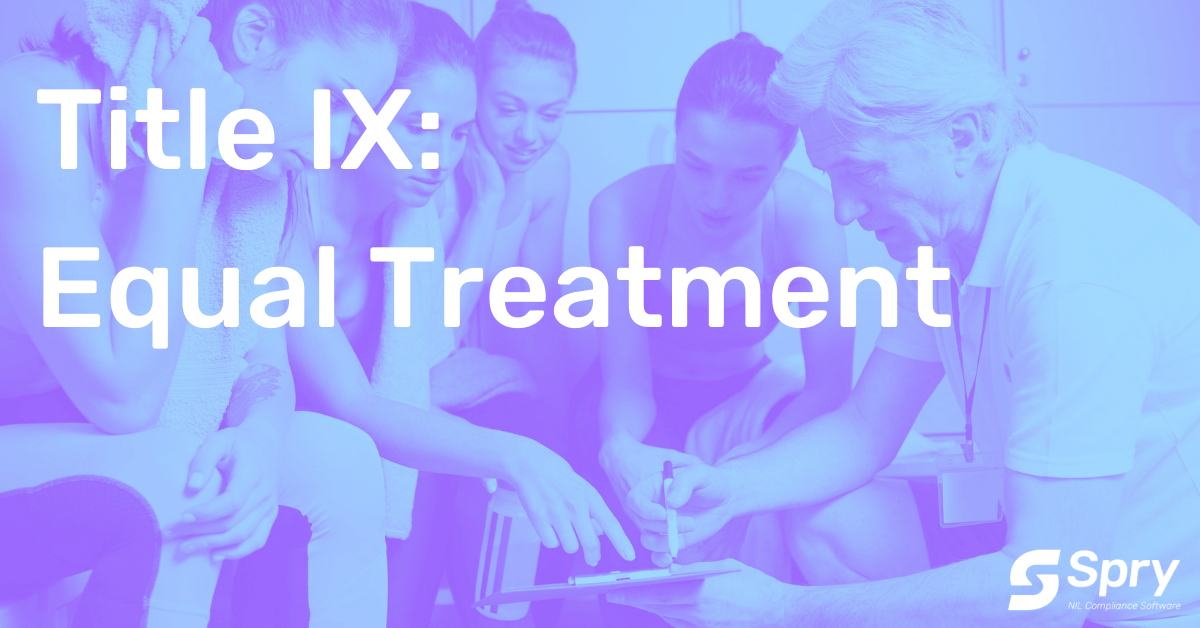Insights
Title IX: Equal Treatment

Equal Treatment
As we said earlier, passing the three-part test only gets an institution halfway to compliance with Title IX. In addition to providing fair access, they must also demonstrate equal treatment of both genders throughout the course of their participation. For Title IX purposes, equal treatment is determined by assessing 12 specific categories which are often referred to as the “laundry list”.
Scholarships
Actual scholarship expenditures will not be equal if a school is not meeting proportionality, however schools should avoid obvious disparities between male and female programs when it comes to scholarship allocations. For example, if all men’s sports are fully funded to the extent allowed by the NCAA on the men’s side, it would not be equitable to have women’s programs funded below the NCAA equivalency/counter limits. Compliance staff and business managers are the individuals best positioned to monitor department scholarship expenditures.
Coaching
Salary and benefits should be relatively comparable between male and female coaches. There will obviously be certain market forces that will impact this, but ADs and sport administrators should regularly review coaches’ contracts to ensure that incentives and perks such as courtesy cars, clothing allowances and club memberships are relatively equivalent.
Facilities
In addition to the venues in which men’s and women’s sports compete, practice and training facilities should be comparable as well, including the times during which each program has access to such facilities. If programs have separate training facilities, they should be outfitted with the same amenities. If both programs share a training facility, a recommended practice would be to alternate times so that neither group enjoys a perceived advantage. A designated staff member should be charged with periodically reviewing facility access and usage within the department.
Recruitment
Recruiting budgets should be relatively comparable between programs. For example, if programs of one gender have the means to recruit nationally, it would not be recommended that programs of the opposite gender are limited to a regional recruiting footprint.
Equipment
While equipment needs will undoubtedly vary among different sports, providing comparable resources for equipment within like sports is a recommended practice for institutions. While equipment managers may not have the ability to make budgetary decisions on all campuses, they should at a minimum be aware of significant differences and be empowered to raise those issues for further consideration.
Scheduling
As with recruiting, neither gender should enjoy a decided advantage with regard to scheduling. If one gender is relegated to a local or regional schedule, while the other is allowed to gain exposure by playing a national schedule, this would constitute unequal treatment under Title IX. As a best practice, sport administrators should review team schedules with this issue in mind.
Team travel
Travel should not only be roughly equivalent in terms of location, but mode of transportation is a critical component of this assessment as well. Sport administrators should be cognizant of which programs are allowed to charter flights versus flying commercial, or flying versus driving. A best practice would be to have consistent departmental policies that dictate when teams are allowed to drive, fly or charter. For example, a policy might stipulate that all teams would travel by bus for any road contest within a 300 mile radius, and outside of that distance all teams would fly. One issue that institutions may not be aware of is that the athletic resources devoted to things like team travel, etc are not the only factor that is considered in a Title IX analysis. Sport specific donations from donors that result in one program having access to flights or other privileges not granted equally to both genders could still leave institutions exposed to Title IX issues.
Tutoring
Tutoring services should be accessible to all student-athletes, regardless of the sport. Again, department wide policies that are overseen by a senior level administrator will help to ensure equity. For instance, a policy that granted access to tutoring services for all student-athletes below a certain GPA would address the equal treatment clause under Title IX.
Medical Services
Medical decisions will always be made on a case-by-case basis at the discretion of a medical professional, so there is not an expectation that there will necessarily be consistency among medical expenditures. However, one of the best ways an athletic department could ensure equity in this area is to have an objective process for how athletic training personnel are assigned. Women’s golf would certainly not require the same number of trainers as the football team, but establishing set ratios the guarantee a trainer per certain number of athletes is a recommended Title IX and health and safety measure.
Housing and Dining
NCAA rules already govern housing assignments to some degree, however it is still advisable for athletic departments to give attention to where clusters of student-athletes are being housed. This would naturally be the responsibility of the athletics designee who serves as the liaison to the Housing office. Also, while individual meal plans may vary based on scholarship levels, amenities like training tables and nutrition zones should be equally accessible to all student-athletes as well. Athletic departments that employ a nutritionists should designate this individual to oversee this task.
Support Services
Any academic and personal/career development services that are provided by an institution also fall under the purview of Title IX. Individuals in charge of programming these services should carefully monitor whether the programs of both genders are granted equal access.
Publicity
Publicity can be a challenge since certain higher profile programs will naturally garner more public interest and attention, however departments should be aware that the resources they devote to promoting male versus female sports is a factor that will become part of the Title IX analysis.
Read part one of our Title IX series here



